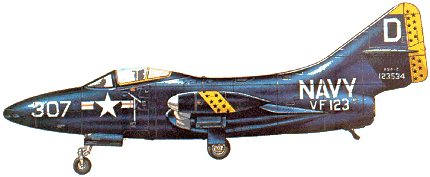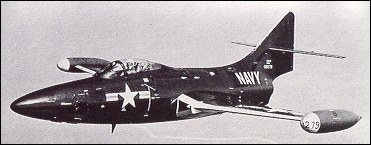|
| The original layout of this single-seat carrier-based fighter provided for the installation of four wing-mounted Westinghouse 19XB-2B (Navy J30) axial-flow jets. But this arrangement was abandoned in favour of one fuselage-mounted high-powered turbojet engine before prototype construction began, a change prompted by the successful tests conducted by the Navy in December 1946 with two imported Rolls-Royce Nene engines.
The first prototype XF9F-2 was powered by an imported Nene engine and flew for the first time on 24 November 1947. The second prototype was similarly fitted, but the third (the XF9F-3) had an Allison J33 engine. Production aircraft were divided between Nene and Allison-powered models, the former engines licence-built by Pratt & Whitney as J42s.
The first production F9F-2, powered by a 22.24kN J42-P-6, flew for the first time on 24 November 1948. The 20.46kN J33-A-8-powered prototype flew for the first time on 15 August 1948 and a total of 418 of both versions were built. However the F9F-2 proved to be the better version and the F9F-3s were re-engined to F9F-2 standard. The F9F-4 (73 of which were ordered originally) was powered by an Allison J33-A-16 engine, but none was completed and the contracts were combined with those for more than 580 27.80kN Pratt & Whitney J48-P-4/6A-engined F9F-5s (which flew for the first time on 21 December 1949). The F9F-5P was a photographic-reconnaissance version with a longer camera nose.
Panthers are remembered in US Navy history as their first jet fighter to be used in combat, introduced into the Korean War on 3 July 1950, as well as for recording a victory against an enemy jet aircraft, a MiG-15, on 9 November 1950.

| MODEL | F9F-5 |
| CREW | 1 |
| ENGINE | 1 x Pratt & Whitney J48-P-6A turbo-jet, 27.8kN |
| WEIGHTS |
| Take-off weight | 8492 kg | 18722 lb |
| Empty weight | 4603 kg | 10148 lb |
| DIMENSIONS |
| Wingspan | 11.58 m | 38 ft 0 in |
| Length | 11.84 m | 39 ft 10 in |
| Height | 3.73 m | 12 ft 3 in |
| Wing area | 23.23 m2 | 250.05 sq ft |
| PERFORMANCE |
| Max. speed | 932 km/h | 579 mph |
| Cruise speed | 774 km/h | 481 mph |
| Ceiling | 13045 m | 42800 ft |
| Range | 2092 km | 1300 miles |
| ARMAMENT | 4 x 20mm cannon, 2 x 454kg bombs or 6 x 127mm missiles |
 | A three-view drawing of F9F-2 Panther (1278 x 902) |
| Rolf Noll, e-mail, 02.11.2010 20:17 Flew the "Duece" in early 1955 as a Navcad at NAS Corpus. Remembered it as easy and fun to fly. Went thru the VA syllabus which meant less air to air gunnery and some air to ground hops. reply | | Howard Nickerson, e-mail, 25.10.2010 20:25 Flew the F9F-2 as a student Naval Aviator in ATU-206 at Forest Sherman Field in 1958. reply | | bill bearchell, e-mail, 11.08.2010 04:54 I flew out of El Toro in the late 50s with VMA 224. Great airplane. reply | | bill bearchell, e-mail, 11.08.2010 04:53 I flew out of El Toro in the late 50s with MA 224. Great airplne. reply | |
| | William (Bill) Metcalfe, e-mail, 22.08.2010 04:25 Stationed at MCAS El Tora and manuvered at El Centro then served as structural mechanic with VMF-223 out of Hawaii and made cruise on the Essex in 1953-1954. reply | | Fred Wicknick, e-mail, 12.01.2010 00:06 I flew the F9F-5 out of MCAS El Toro in Southern California from June 1955 to June 1956 with VMF /A - 323 - the "Death Rattlers". The squadron was in training and had many pilots and few planes. We flew air to air gunnery practice over San Clemente Island and air to ground gunnery practice in the desert out of MCAAS El Centro. This was a great plane to fly. We would take off in divisions - a formation of four aircraft all rolling down the runway together. With slight adjusment of the power control we could maintain our position both on the ground and in the air.
Often we would climb out over the desert of Southern California and tangle with the Air Force planes out of their several bases. These mock dog fights would often find dozens of aircraft dodging and weaving in the same airspace. Things would happen so quickly that it was very difficult for a wingman to stay with his leader. It was not possible to keep tract of all the planes in your part of the sky. But the F9F-5 would do anytning you wanted except to match the speed of the much faster Air Force planes.
But what an advernture for a young man that never considered the danger involved. It was pure fun. reply | | Patrick K. Morrison, e-mail, 16.04.2009 04:00 Correction to information previously provided. He was stationed on the Essex cv9 in 1951 not 48-49. He was stationed on Patron squadron 1,2,3 in 48&49.
Sorry for the incorrect info. reply | | Patrick K. Morrison, e-mail, 16.04.2009 04:00 Correction to information previously provided. He was stationed on the Essex cv9 in 1951 not 48-49. He was stationed on Patron squadron 1,2,3 in 48&49.
Sorry for the incorrect info. reply | | Patrick K. Morrison, e-mail, 16.04.2009 02:27 My step father was origionaly on the Essex (CV-9)in 1948-49. His cruise book from when he was based on it states that his carrier was the first to have the F9F (Panther) and the F2H (Banshee) which was a twin jet. I will grill him a little more for some old stories. He was on the fuel crew on deck. Had to be a site to see. reply | | Richard A. Picard, e-mail, 06.05.2008 20:31 I have worked on many aircraft and enjoyed the history and technology especially with Grumman Aircraft. My latest adventure is the restoration of a privately owned F9F-2 by the USS Saratoga Museum at Quonset Point, Rhode Island. Until a few years ago this was an airworthy aircraft and now will be restored to its original configuration. The USS Saratoga Museum is always looking for information, volunteers and items relating to this historic aircraft. reply | | Bill Paulson, e-mail, 22.04.2008 05:34 Have always liked the color of this aircraft and would like to have specs, if possible, for the paint so I can paint a "toy" {older Corvette} some day. reply |
|
Do you have any comments?
|
| 
COMPANY
PROFILE
All the World's Rotorcraft
|








